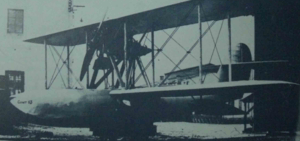CANT 13
The CANT 13 was an amphibious aircraft designed for use on Regia Marina ships in response to a 1925 competition.
| CANT 13 | |
|---|---|
 | |
| Role | Shipboard amphibious aircraft |
| Manufacturer | CANT |
| Designer | Raffaele Conflenti |
| First flight | 1925 |
| Number built | 2 |
Design
The CANT 13 was a conventional amphibious aircraft, a two-seater single-engined biplane amphibian with retractable undercarriage, made entirely of wood. The hull had an open two-seat side-by-side cockpit with an internal passage that allowed the second member of the crew to reach the two defensive positions, front and rear, both equipped with a machine gun. The equal span foldable wings were connected by a pair of inter-plane struts on each side, braced by tie rods in steel cable, with the upper wing equipped with ailerons. The landing gear was manually retractable operated by the pilot. Propulsion was supplied by a Lorraine-Dietrich 12Db liquid-cooled V-12 delivering 400 hp (300 kW), driving with a fixed-pitch 2-bladed propeller placed between the two wings above the hull on a tubular steel central supporting .
Development
In 1925 the Ministry of Aeronautics issued a specification for the supply of a new amphibious aircraft to equip naval units of the Regia Marina. The CNT took part in the competition with a project entrusted to the engineer Raffaele Conflenti.
Two aircraft were built and were evaluated by the Regia Aeronautica but due to changes in the plans of the General Staff, no mass production was decided, but they were employed by the Regia Marina for at least the following two years.
Specifications
Data from C.N.T. CANT.13[1]
General characteristics
- Crew: 2
- Length: 10 m (32 ft 10 in)
- Wingspan: 14.68 m (48 ft 2 in)
- Powerplant: 1 × Lorraine-Dietrich 12Db V-12 water-cooled piston engine, 300 kW (400 hp)
- Propellers: 2-bladed fixed pitch propeller
Performance
- Maximum speed: 190 km/h (120 mph, 100 kn)
- Range: 1,150 km (710 mi, 620 nmi)
- Service ceiling: 4,600 m (15,100 ft)
Armament
- Guns: 2 × 7.7 mm (0.303 in) Lewis guns
- Bombs: 100 kg (220 lb) of bombs
References
| Wikimedia Commons has media related to CANT 13. |
- Giorgio, Giorgio. "C.N.T. CANT.13". giemmesesto.com (in Italian). Archived from the original on 5 March 2016. Retrieved 23 January 2019.
Further reading
- Garello, G.; Zorini, D. (2003). Le Officine aeronautiche CANT 1923 – 1945 (in Italian). Ufficio Storico Aeronautica Militare.